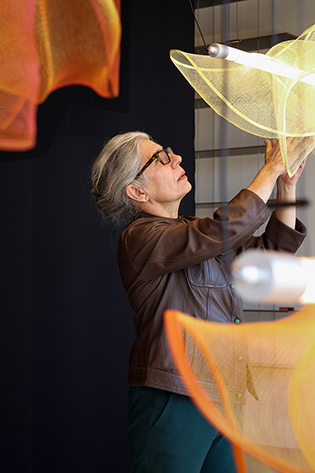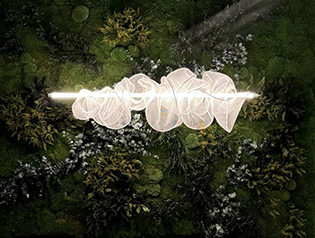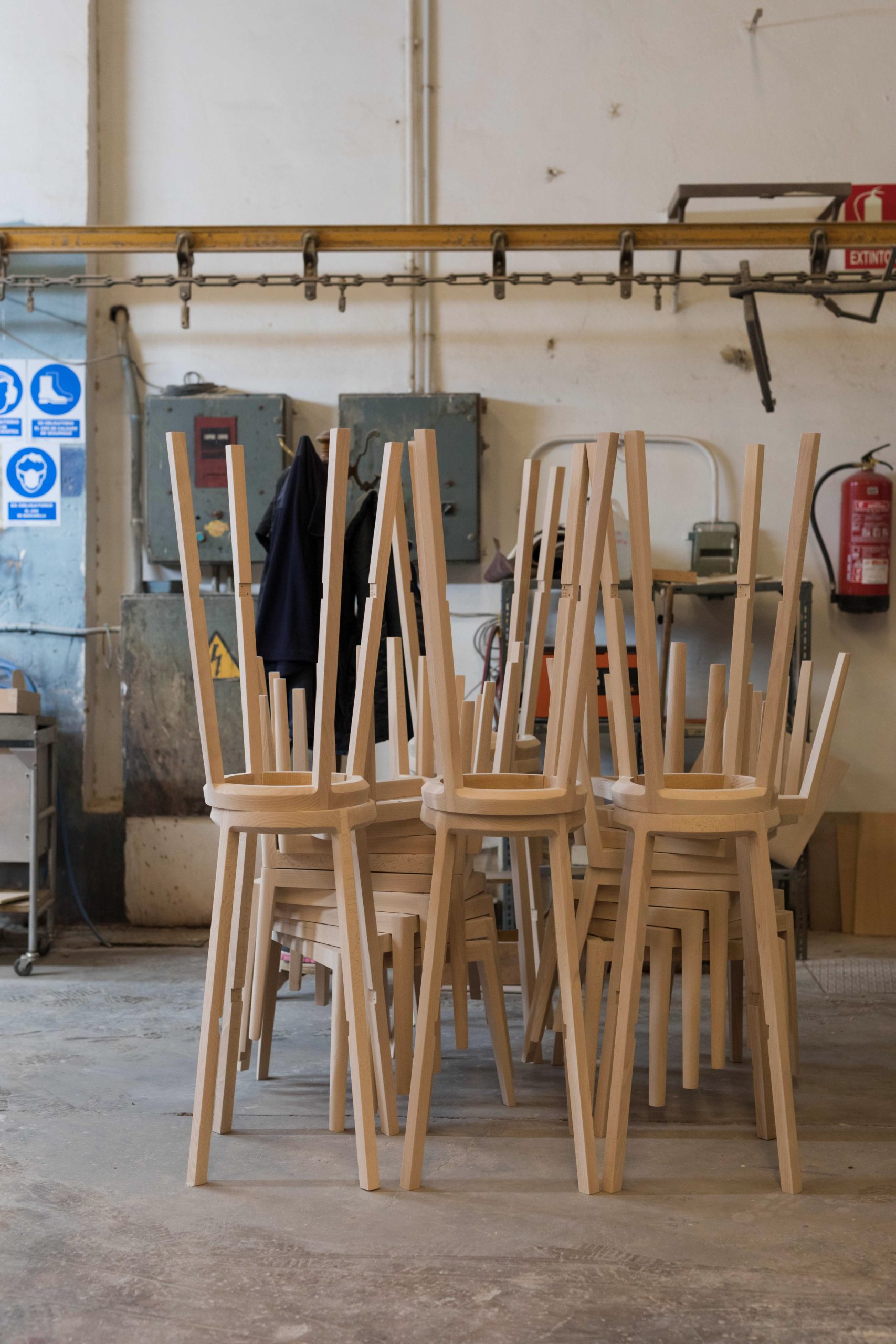KlunderBie is a creative tour de force masterminded by Nienke Klunder and Wiglius de Bie. Established in 2012, the studio is a proponent of the photographic avant-garde. Graduating together from the St. Joost School of Art & Design, Nienke and Wiglius embarked on separate journeys, before reconnecting years later. Today, through KlunderBie, they approach their work with a knowing confidence, a polished urbanity, an experienced eye, and a quirky sense of humour. Their photography is an expression of passion and precision, where colour is often the protagonist and imagination knows no bounds.

KlunderBie founders Nienke Klunder and Wiglius de Bie.
Say hello to KlunderBie.
Nienke Klunder and Wiglius de Bie made the perfect pair for LZF’s people with character series.
What are five words that best describe KlunderBie?
Colourful, witty, balanced, dreamers, and fantastic.
You both moved from the Netherlands to Valencia, via a number of cities and places in-between. How have your respective backgrounds influenced your creative vision?
We have known each other for many years and share a lot of references. We are both Dutch and that’s an important base for our mutual understanding. We went to art school together, where we became good friends. We were living in Antwerp and our first collaboration was during this time: we shot the then young fashion designer Kris van Assche’s graduation project (he is now the creative director of Berluti). We went our separate ways after graduating, not knowing that years later our working paths would cross again.
(Wiglius) I spent time in Paris, New York, and London, where I focused on fashion and portrait photography. I learned with the photographers Roxanne Lowit and Mario Testino among others, and my clients included Vogue and Dior Homme.
(Nienke) I was invited to Italy to work for Fabrica (Benetton’s creative research centre, led by photographer Oliviero Toscani). This is where I met the Spanish designer Jaime Hayon. We became a couple and worked together for the next fifteen years, building the pillars of Hayon Studio. Here, I dipped into a world of form and colour, aesthetics and design. With my broad-ranging interest in art and my education, I enjoyed creating strong concepts for campaigns, products, and spaces. In the design world, there was a lack of storytelling, a gap which could easily be filled.

Photography for the ‘Living’ design supplement in Corriere della Sera.
Our paths crossed in Barcelona, New York, London, and Paris, before we undertook our first ‘professional’ collaboration. That was at the American furniture company Bernhardt Design, with Dutch designers Kiki van Eijk and Joost van Bleiswijk. We realised that by blending our creative expertise—in fashion, portraiture, design, and art—we could explore a range of avenues: four eyes see more than two. What initially started as an on–off, fun project, continues to be an ongoing adventure. It was the perfect match.
Your work is an expression of both rich and subtle meanings. What is your creative process?
We analyse the client and the product, and search for inspiration that best reflects the mood of the job. Having inspiration gives you a basis, acting like a frame for the whole process—it helps us to know when a composition and style will work.
It’s important to add subtle meanings and layers: in this way, we don’t grow bored with our work. Those meanings and layers draw inspiration from art, movies, fashion, history, and everyday life. It could be a small detail that no one notices, but it helps us to enjoy the work even more, and adds another level of meaning. On top of that, we have a mutual sense of humour and understanding—this is important in terms of achieving the final result.

Artwork by KlunderBie for Danish brand Fritz Hansen. Can you spot Arne Jacobsen’s Ant chair?
In your latest project, you created the artwork for two restaurants (Restaurant Azul and Taberna de Tapas) on-board ‘Galicia’, a new ship launched by Brittany Ferries. What was the inspiration behind the artwork?
For Galicia’s Restaurant Azul, we were asked to make something timeless, yet modern. It had to reflect the spirit and traditions of the Galician region, and take a fresh approach to the Spanish west coast. The client (Brittany Ferries) had already seen—and liked—our work at the Hotel Barceló Torre de Madrid, whose interiors were designed by Jaime Hayon. It was clear to us from the outset that we didn’t want to repeat the same thing. In order to keep the project real, we went to Galicia to get a feel for the region and to meet the people there.

Artwork by KlunderBie for Galicia’s Restaurant Azul.
We met Rosa Segade, the owner of ‘de Cotío’, a renowned fashion and accessories shop in Santiago de Compostela (Galicia’s capital). Rosa is an expert and a leader in making the most beautiful traditional Galician clothes. Together with her associate Montse, they perfectly styled a series of portraits in traditional clothing, that are now exhibited in Restaurant Azul. We shot the portraits at an improvised photo studio in the heart of Santiago de Compostela, and in the city’s streets. By playing with graphical lines and colourful panels, we gave the photos a contemporary feel. At the same time, the styling was traditional, providing a balance between the old and the new. As a reference to the ship’s round portholes, the finished photos were round: we felt this was a fresh way to present our work.

Artwork by KlunderBie for Galicia’s Restaurant Azul.

Artwork by KlunderBie for Galicia’s Taberna de Tapas.
To create a pleasing balance with the Restaurant Azul’s portraits, we chose to produce a series of still-life compositions for the Galicia ferry’s second restaurant, Taberna de Tapas. We made these in collaboration with ‘Sargadelos’, a famous Galician ceramic brand. Along with their ceramics, we included various objects and products from Galicia: seashells, food, gourds, and references to the ‘Camino de Santiago’ pilgrimage. We created three-dimensional collages, using iconic Spanish imaginary for inspiration.

Artwork by KlunderBie for Galicia’s Taberna de Tapas.
Colour is a big part of your work—what is your relationship with colour?
Colour is attractive; it brings ambience and happiness. When colour is well balanced, it is powerful. Ever since we started working in Spain, our work changed considerably. Coming from the Netherlands, we aren’t able to avoid the influence of the Dutch masters or the northern light. But in Spain, the sunlight, the colours, and the culture, have each influenced our work. In a way, life in Spain seems freer and more colourful than life in the Netherlands. That said, we still find it important to add a little Dutch touch to our creations.

‘Paesaggi Metafisici’ (Metaphysical Landscapes) for ‘Living’ in Corriere della Sera.
At first glance, a KlunderBie image appears to have a number of random elements. Yet the opposite is in fact true—everything is there for a reason and placed with precision. With this in mind, does your life imitate art?
This is a difficult question and we’re not sure how to interpret it—we certainly never thought about it in this way. Our photographs are always well thought through, and indeed everything is placed with precision. We see our photographs as canvases and we feel like painters, slowly filling in the gaps as we add elements to the composition. As for the relation between life and work, we do recognise ourselves perfectly in our work. In one form or another, our personalities reflect the final results of our photographs.

You have collaborated with a wide range of clients, across fashion, design, and art. What do you look for in a collaborative relationship?
Ideally, we look for the same qualities that we find in our own collaboration: partnership, space for thoughts, clashes, and inspiration, freedom, friendship, and a sense humour. We are often given carte blanche to create, something we believe leads to the best results.
Today, everyone is a photographer. As photographers, how do you feel about a behemoth such as Instagram and its affect on creativity?
We believe that creativity itself will always be there—it will adapt to time and mediums. The world of creativity has become more challenging. As you say, everyone can make a photo and we do think it affects opportunities for actual creatives. In many cases, having thousands of followers is more important than being a great artist. As a photographer, the best way to differentiate yourself from those people with thousands of followers, is by having good concepts and developing a personal style. But it is hard to be ‘seen’. For us, Instagram is addictive, in a nice way, and good for work. We couldn’t think of a better agent for our work: people discover KlunderBie through Instagram, we’ve received quite a few job offers, and we’ve had enquiries about buying our photographs.
Are there any design clichés that you find especially irritating or redundant, or conversely, that you live by?
Nowadays, it seems design has become a globalised fashion, changing with the seasons and invariably similar, no matter where you are. From a creative perspective, it can be a source of annoyance to travel to as city such as Tokyo, and find cafes that look no different from those at home. We love things that are unique; we both feel it is important to create a pleasing and personal atmosphere in our respective abodes. Design aside, it is important to feel at home.

Artwork by KlunderBie for Hotel Barceló Torre de Madrid.
Given carte blanche, what five people would you invite to a dinner party?
(Wiglius) 5 x my Dad.
(Nienke) I’ll join Wiglius in that idea. His Dad was always inspiring, and a very special man. It will be a great dinner.
All photos © KlunderBie.














